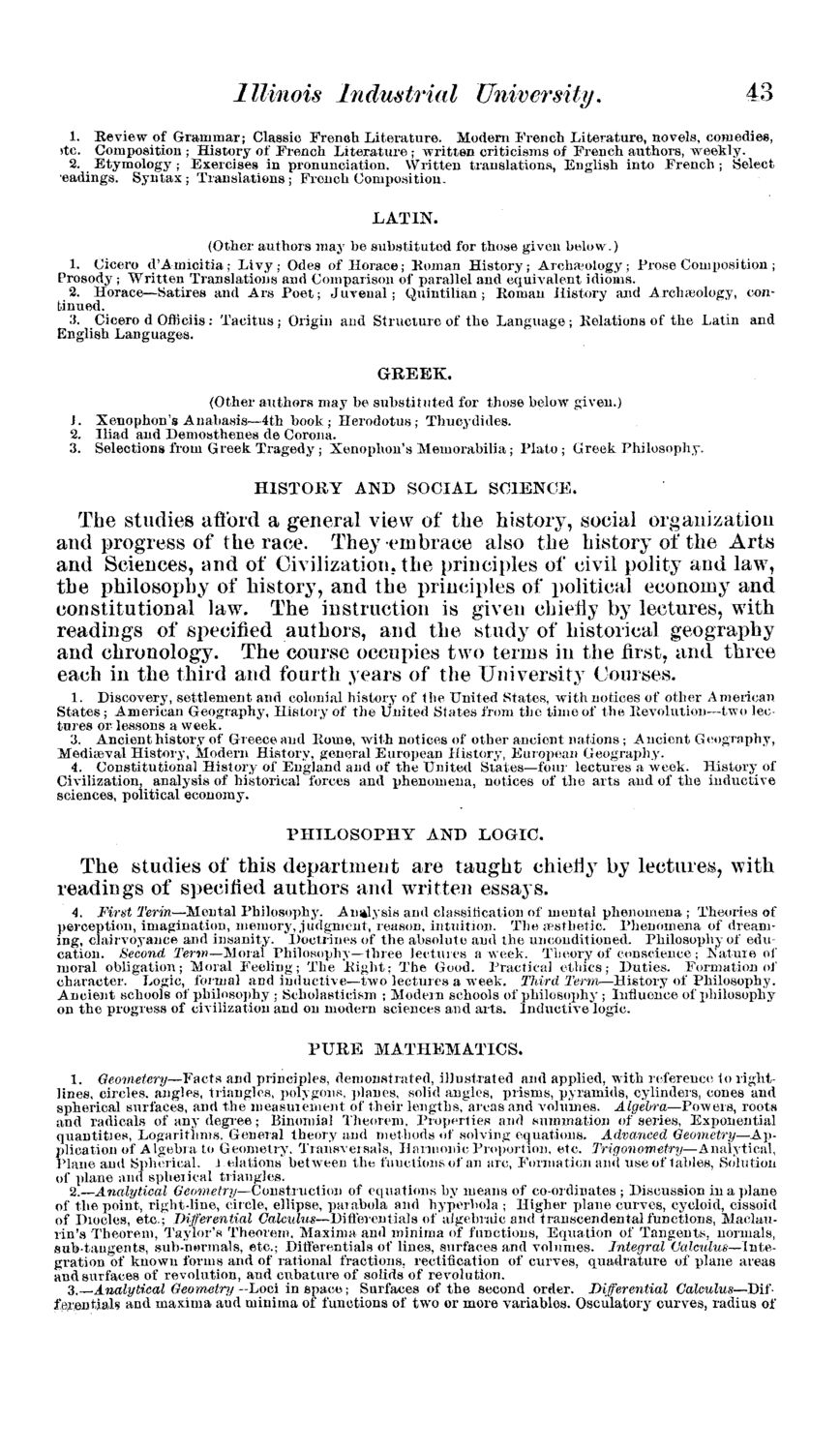| |
| |
Caption: Board of Trustees Minutes - 1874
This is a reduced-resolution page image for fast online browsing.

EXTRACTED TEXT FROM PAGE:
Illinois Industrial University. 43 1. Eeview of Grammar; Classic French Literature. Modern French Literature, novels, comedies, >tc. Composition ; History of French Literature ; written criticisms of French authors, weekly. 2. Etymology ; Exercises in pronunciation. Written translations, English into French ; Select eadings. Syntax; Translations; French Composition. LATIN. (Other authors may be substituted for those given below.) 1. Cicero d'Amicitia; L i v y ; Odes of Horace; Roman History; Archaeology; Prose Composition ; Prosody ; Written Translations and Comparison of parallel and equivalent idioms. 2. Horace—Satires and Ars Poet; Juvenal; Quintilian ; Roman History and Archaeology, continued. 3. Cicero d Officiis: Tacitus ; Origin and Structure of the Language ; Relations of the Latin and English Languages. GREEK. (Other authors may be substituted for those below given.) J. Xenophon's Anabasis—4th book; Herodotus; Thucydides. 2. Iliad and Demosthenes de Corona. 3. Selections from Greek Tragedy ; Xenophon's Memorabilia; Plato ; Greek Philosophy. HISTORY AND SOCIAL SCIENCE. The studies afford a general view of the history, social organization and progress of the race. They embrace also the history of the Arts and Sciences, and of Civilization, the principles of civil polity and law, the philosophy of history, and the principles of political economy and constitutional law. The instruction is given ehieiiy by lectures, with readings of specified authors, and the study of historical geography and chronology. The course occupies two terms in the first, and three each in the third and fourth years of the University Courses. 1. Discovery, settlement and colonial history of the United States, with notices of other American States ; American Geography, History of the United States from the time of the Revolution—two lectures or lessons a week. 3. Ancient history of Greece and Rome, with notices of other ancient nations ; Ancient Geography, Mediaeval History, Modern History, general European History, European Geography. 4. Constitutional History of England and of the United States—four lectures a week. History of Civilization, analysis of historical forces and phenomena, notices of the arts and of the inductive sciences, political economy. PHILOSOPHY AND LOGIC. The studies of this department are taught chiefly by lectures, with readings of specified authors and written essays. 4. First Term—Mental Philosophy. Analysis and classification of mental phenomena ; Theories of perception, imagination, memory, judgment, reason, intuition. The aesthetic. Phenomena of dreaming, clairvoyance and insanity. Doctrines of the absolute and the unconditioned. Philosophy of education. Second Terin—Moral Philosophy—three lectures a week. Theory of conscience; Katuie of moral obligation; Moral Feeling; The Right; The Good. Practical ethics; Duties. Formation of character. Logic, formal and inductive—two lectures a week. Third Term—History of Philosophy. Ancient schools of philosophy ; Scholasticism ; Modern schools of philosophy ; Influence of philosophy on the progress of civilization and on modern sciences and arts. Inductive logic. P U R E MATHEMATICS. 1. Geometery—Facts and principles, demonstrated, illustrated and applied, with reference to rightlines, circles, angles, triangles, polygons, planes, solid angles, prisms, pyramids, cylinders, cones and spherical surfaces, and the'measurement of their lengths, areas and volumes. Algebra—Powers, roots and radicals of any degree; Binomial Theorem, Properties and summation of series, Exponential quantities, Logarithms, General theory and methods of solving equations. Advanced Geometry—Application of Algebra to Geometry, Transversals, Harmonic Proportion, etc. Trigonometry—Analytical, Plane and Spherical. J elations between the functions of an arc, Formation and use of tables, Solution of plane and spheiical triangles. 2.—Analytical Geometry—Construction of equations by means of co-ordinates ; Discussion in a plane of the point, right-line, circle, ellipse, parabola and hyperbola ; Higher plane curves, cycloid, cissoid of Diodes, etc.; inferential Calculus—Differentials of'algebraic and transcendental functions, Maclaurin's Theorem, Taylor's Theorem, Maxima and minima of functions, Equation of Tangents, normals, sub-tangents, sub-normals, etc.; Differentials of lines, surfaces and volumes. Integral Calculus—Integration of kuown forms and of rational fractions, rectification of curves, quadrature of plane areas and surfaces of revolution, and cubature of solids of revolution. 3.—Analytical Geometry —Loci in space; Surfaces of the second order. Differential Calculus—Differentials? and maxima aud minima of functions of two or more variables. Osculatory curves, radius of
| |